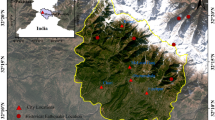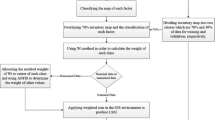Abstract
The landslide studies can be categorized as pre- and postdisaster studies. The predisaster studies include spatial prediction of potential landslide zones known as landslide susceptibility zonation (LSZ) mapping to identify the areas/locales susceptible to landslide hazard. The LSZ maps provide an assessment of the safety of existing habitations and infrastructural/functional elements and help plan further developmental activities in the hilly regions. Landslides are one of the natural geohazards that affect at least 15% of land area of India. Different types of landslides occur frequently in geodynamical active domains of the Himalayas. In India, various techniques have been developed and adopted for LSZ mapping of different regions. However, the technique for LSZ mapping is not yet standardized. The present research is an attempt in this direction only. In our earlier work (Kanungo et al. 2006), a detailed study on conventional, artificial neural network (ANN)- black box-, fuzzy set-based and combined neural and fuzzy weighting techniques for LSZ mapping in Darjeeling Himalayas has been documented. In this paper, other techniques such as combined neural and certainty factor concept along with combined neural and likelihood ratio techniques have been assessed in comparison with combined neural and fuzzy technique for the preparation of LSZ maps of the same study area in parts of Darjeeling Himalayas. It is observed from the present study that the LSZ map produced using combined neural and fuzzy approach appears to be the most accurate one as in this case only 2.3% of the total area is found to be categorized as very high susceptibility zone and contains 30.1% of the existing landslide area. This approach can serve as one of the key objective approaches for spatial prediction of landslide hazards in hilly terrain.










Similar content being viewed by others
References
Anbalagan R (1992) Landslide hazard evaluation and zonation mapping in mountainous terrain. Eng Geol 32:269–277
Arora MK, Das Gupta AS, Gupta RP (2004) An artificial neural network approach for landslide hazard zonation in the Bhagirathi (Ganga) Valley, Himalayas. Int J Remote Sens 25(3):559–572
Chi K-H, Park N-W, Lee K (2002a) Identification of landslide area using remote sensing data and quantitative assessment of landslide hazard. In: Proceedings of IEEE international geosciences and remote sensing symposium, 19 July, Toronto, Canada
Chi K-H, Park N-W, Chung C-J (2002b) Fuzzy Logic Integration for landslide hazard mapping using spatial data from Boeun, Korea. In: Proceedings of symposium on geospatial theory, processing and applications, Ottawa
Chung C-JF, Fabbri AG (1999) Probabilistic prediction models for landslide hazard mapping. Photogramm Eng Remote Sens 65(12):1389–1399
Clerici A, Perego S, Tellini C, Vescovi P (2002) A procedure for landslide susceptibility zonation by the conditional analysis method. Geomorphology 48:349–364
Dhakal AS, Amada T, Aniya M (2000) Landslide hazard mapping and its evaluation using GIS: an investigation of sampling schemes for a grid-cell based quantitative method. Photogramm Eng Remote Sens 66(8):981–989
Elias PB, Bandis SC (2000) Neurofuzzy systems in landslide hazard assessment. In: Proceedings of 4th international symposium on spatial accuracy assessment in natural resources and environmental sciences, July 2000, pp 199–202
Ercanoglu M, Gokceoglu C (2004) Use of fuzzy relations to produce landslide susceptibility map of a landslide pron area (West Black Sea Region, Turkey). Eng Geol 75(3&4):229–250
Gomez H, Kavzoglu T (2005) Assessment of shallow landslide susceptibility using artificial neural networks in Jabonosa River Basin, Venezuela. Eng Geol 78(1–2):11–27
Gorsevski PV, Gessler PE, Jankowski P (2003) Integrating a fuzzy k-means classification and a Bayesian approach for spatial prediction of landslide hazard. J Geograph Syst 5:223–251
Gupta RP (2003) Remote sensing geology, 2nd edn. Springer, Berlin
Gupta RP, Joshi BC (1990) Landslide hazard zonation using the GIS approach—a case study from the Ramganga Catchment, Himalayas. Eng Geol 28:119–131
Gupta V, Sah MP, Virdi NS, Bartarya SK (1993) Landslide hazard zonation in the Upper Satlej Valley, District Kinnaur, Himachal Pradesh. J Himal Geol 4:81–93
Gupta RP, Saha AK, Arora MK, Kumar A (1999) Landslide hazard zonation in a part of Bhagirathy Valley, Garhwal Himalayas, using integrated remote sensing–GIS. J Himal Geol 20(2):71–85
Hagan MT, Mehnaj M (1994) Training feedforward networks with the Marquardt algorithm. IEEE Trans Neural Netw 5(6):989–993
Hagan MT, Demuth HB, Beale MH (1996) Neural network design. PWS Publishing, Boston
Haykin S (1999) Neural networks: a comprehensive foundation, 2nd edn. Prentice Hall, New Jersey
He YP, Xie H, Cui P, Wei FQ, Zhong DL, Gardner JS (2003) GIS-based hazard mapping and zonation of debris flows in Xiaojiang Basin, Southwestern China. Env Geol 45:286–293
Heckerman D (1986) Probabilistic interpretation of MYCIN’s certainty factors. In: Kanal LN, Lemmer JF (eds) Uncertainty in artificial intelligence. Elsevier, New York, pp 298–311
Kanungo DP, Arora MK, Sarkar S, Gupta RP (2006) A comparative study of conventional, ANN black box, fuzzy and combined neural and fuzzy weighting procedures for landslide susceptibility zonation in Darjeeling Himalayas. Eng Geol 85:347–366
Kanungo DP, Arora MK, Sarkar S, Gupta RP (2009) A fuzzy set based approach for integration of thematic maps for landslide susceptibility zonation. Georisk: Assess Manage Risk Eng Syst Geohazards 3(1):30–43
Lan HX, Zhou CH, Wang LJ, Zhang HY, Li RH (2004) Landslide hazard spatial analysis and prediction using GIS in the Xiaojiang Watershed, Yunnan, China. Eng Geol 76:109–128
Lee S, Min KD (2001) Statistical analysis of landslide susceptibility at Yongin, Korea. Env Geol 40(9):1095–1113
Lee S, Choi J, Chwae U, Chang B (2002a) Landslide susceptibility analysis using weight of evidence. In: Proceedings of IEEE international geosciences and remote sensing symposium, 19 July, Toronto, Canada
Lee S, Choi J, Min KD (2002b) Landslide susceptibility analysis and verification using the Bayesian probability model. Env Geol 43:120–131
Lee S, Ryu J, Won J, Park H (2004) Determination and application of the weights for landslide susceptibility mapping using an artificial neural network. Eng Geol 71:289–302
Lin M-L, Tung C-C (2003) A GIS-based potential analysis of the landslides induced by the Chi-Chi earthquake. Eng Geol 71:63–77
Lu PF, An P (1999) A metric for spatial data layers in favorability mapping for geological events. IEEE Trans Geosci Remote Sens 37:1194–1198
Mehrotra GS, Sarkar S, Kanungo DP, Mahadevaiah K (1996) Terrain analysis and spatial assessment of landslide hazards in parts of Sikkim Himalaya. Geol Soc India 47:491–498
Metternicht G, Gonzalez S (2005) FUERO: foundations of a fuzzy exploratory model for soil erosion hazard prediction. Environ Model Softw 20(6):715–728
Nagarajan R, Mukherjee A, Roy A, Khire MV (1998) Temporal remote sensing data and GIS application in landslide hazard zonation of part of Western Ghat, India. Int J Remote Sens 19(4):573–585
Pachauri AK, Pant M (1992) Landslide hazard mapping based on geological attributes. Eng Geol 32:81–100
Ripley B (1996) Pattern recognition and neural networks. Cambridge University Press, Cambridge
Saha AK, Gupta RP, Arora MK (2002) GIS-based landslide hazard zonation in a part of the Himalayas. Int J Remote Sens 23:357–369
Saha AK, Gupta RP, Sarkar I, Arora MK, Csaplovics E (2005) An approach for GIS-based statistical landslide susceptibility zonation—with a case study in the Himalayas. Landslides 2:61–69
Sarkar S, Kanungo DP (2004) An integrated approach for landslide susceptibility mapping using remote sensing and GIS. Photogram Eng Remote Sens 70(5):617–625
Sarkar S, Kanungo DP, Mehrotra GS (1995) Landslide hazard zonation: a case study in Garhwal Himalaya, India. Mountain Res Dev 15(4):301–309
Schalkoff RJ (1997) Artificial neural networks. Wiley, New York
Shortliffe EH, Buchanan GG (1975) A model of inexact reasoning in medicine. Math Biosci 23:351–379
Sinha BN, Varma RS, Paul DK (1975) Landslides in Darjeeling District (West Bengal) and adjacent areas. Bull Geol Survey India Series B, no. 36:1–45
Suzen ML, Doyuran V (2004) Data driven bivariate landslide susceptibility assessment using geographical information systems: a method and application to Asarsuyu Catchment, Turkey. Eng Geol 71:303–321
Tangestani MH (2003) Landslide susceptibility mapping using the fuzzy gamma operation in a GIS, Kakan Catchment Area, Iran. In: Proceeding of map India conference 2003
van Westen CJ (1994) GIS in landslide hazard zonation: a review, with examples from the Andes of Colombia. In: Price M, Heywood I (eds) Mountain environments and geographic information system. Taylor & Francis, Basingstoke, pp 135–165
Virdi NS, Sah MP, Bartarya SK (1997) Mass wasting, its manifestations, causes and control: some case histories from Himachal Himalaya. In: Agarwal DK, Krishna AP, Joshi V, Kumar K, Palni MS (eds) Perspectives of mountain risk engineering in the Himalayan Region. Gyanodaya Prakashan, Nainital, pp 111–130
Yesilnacar E, Topal T (2005) Landslide susceptibility mapping: a comparison of logistic regression and neural networks methods in a Medium Scale Study, Hendek region (Turkey). Eng Geol 79:251–266
Zhou W (1999) Verification of the nonparametric characteristics of backpropagation neural networks for image classification. IEEE Trans Geosci Remote Sens 37:771–779
Acknowledgments
The authors are grateful to the Director, CSIR-Central Building Research Institute, Roorkee for granting permission to publish this paper. The suggestions made by the referees to improve the quality of the paper are greatly acknowledged.
Author information
Authors and Affiliations
Corresponding author
Rights and permissions
About this article
Cite this article
Kanungo, D.P., Sarkar, S. & Sharma, S. Combining neural network with fuzzy, certainty factor and likelihood ratio concepts for spatial prediction of landslides. Nat Hazards 59, 1491–1512 (2011). https://doi.org/10.1007/s11069-011-9847-z
Received:
Accepted:
Published:
Issue Date:
DOI: https://doi.org/10.1007/s11069-011-9847-z




